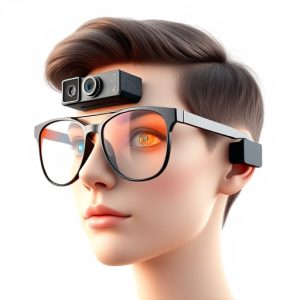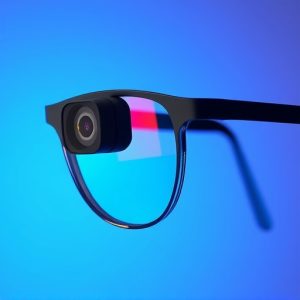Smart Glasses Camera Buying Guide: Price, Features, and Top Brands
Smart glasses with cameras have revolutionized personal photography and augmented reality (AR) exper…….
Smart glasses with cameras have revolutionized personal photography and augmented reality (AR) experiences by blending advanced technology with fashionable eyewear. These devices offer high-resolution imaging on par with dedicated cameras, with user-friendly privacy controls and extended battery life. They come in various price points, from entry-level options that introduce users to AR while maintaining portability, to mid-range and high-end models featuring voice and gesture controls for superior recording experiences. High-end brands like Bose and Oakley have crafted stylish, functional glasses with cameras, such as the Bose Frames and Oakley OO9202, which offer superior audio quality and seamless user interfaces alongside iconic designs. Ray-Ban's Smart Stories and Snap Inc.'s Spectacles are also notable players in this market, consistently improving their products to meet diverse consumer needs. Latest models boast high-definition lenses for quality imaging comparable to standalone cameras, adaptable lighting performance, and energy-efficient hardware that extends battery life and preserves additional features like AR, fitness tracking, and language translation. As these smart glasses evolve with machine learning, they are set to become more intelligent, tailored to user preferences, and an integral part of daily life, enhancing our physical experiences with digital information and visual content.
Explore the fusion of style and technology as we delve into the world of glasses with a camera built in. This article provides an in-depth look at these innovative eyewear pieces, from their cutting-edge features to the cost considerations and top brands vying for your attention. We’ll compare models based on camera quality, battery longevity, and extra functionalities to help you make an informed decision. Additionally, we’ll glance into the future of connectivity to see how smart glasses with cameras are set to revolutionize personal technology. Join us as we offer a clear lens on this burgeoning trend in wearable tech.
Exploring the Features of Glasses with a Built-In Camera: A Comprehensive Guide
When integrating the functionalities of a camera into eyewear, manufacturers have successfully merged utility and fashion with the advent of glasses that come equipped with a camera built in. These smart glasses offer users a hands-free way to capture moments on the fly, seamlessly blending into everyday wear. The integration of this technology into frames is not merely a novelty; it’s a thoughtful design that caters to a variety of use cases, from casual photography enthusiasts to professionals who require documentation or presentational capabilities in a pinch.
These glasses with cameras boast a range of features tailored to enhance the user experience. They are often equipped with high-resolution lenses that can capture stills and videos with clarity comparable to standalone cameras. The built-in cameras are designed with privacy in mind, featuring indicators or switches to activate recording or photography modes, ensuring users have control over when their device is operational. Additionally, the integration of this technology has led to advancements in battery efficiency, allowing these smart glasses to offer extended use between charges without compromising on performance. With the ability to connect wirelessly to smartphones and other devices via Bluetooth or Wi-Fi, users can effortlessly transfer and share their content, making these glasses not just a tool for personal use but also a versatile accessory for professionals and creators alike.
Price Analysis: Understanding the Cost Range of Smart Glasses with Integrated Cameras
The integration of cameras into smart glasses has revolutionized the way we capture and interact with the world around us. As of the current market, the price range for smart glasses equipped with integrated cameras can vary significantly based on a multitude of factors such as brand reputation, feature sophistication, design quality, and overall functionality. Entry-level models often start at a more accessible price point, offering basic recording capabilities and essential augmented reality features. These are typically suited for users looking to explore the functionalities of smart glasses without a substantial investment.
As one moves up the pricing ladder, models emerge with enhanced camera resolutions, extended battery life, and advanced AR applications. High-end smart glasses in this segment often come with premium materials, sleeker designs, and more sophisticated features like voice commands, gesture recognition, and high-definition video recording. These are targeted at consumers who seek a seamless blend of technology with style and performance. Additionally, the price can be influenced by the level of integration between the camera and the smart glasses platform, with some models offering a more cohesive user experience compared to others. It’s pivotal for potential buyers to consider their specific needs and how much they are willing to invest in terms of both functionality and style when selecting from the array of smart glasses with built-in cameras available on the market.
Top Brands Offering Glasses with Camera Functionality
The integration of cameras into eyewear has become a significant trend, with several top brands offering glasses with a camera built in. One such leader in this niche market is Bose Frames, which have subtly incorporated cameras into their audio sunglasses, allowing users to capture moments without drawing unnecessary attention. These smart glasses provide high-quality audio and the ability to record hands-free video or photos, making them a favorite for those seeking functionality without compromising on style.
Another prominent brand in this space is Oakley, known for its innovative designs and high-performance eyewear. Models like the Oakley OO9202 deliver camera functionality with the convenience of touchpad control, offering users a seamless experience. These smart glasses blend cutting-edge technology with Oakley’s iconic design, providing clear optics and robust camera capabilities, suitable for both professional and recreational use. Other notable brands include Ray-Ban, with its Smart Stories glasses, and Snap Inc.’s Spectacles, which have been pioneers in the field of camera-equipped eyewear, continually improving their offerings to meet consumer needs and preferences. These brands cater to a variety of styles and preferences, ensuring that there’s a pair of glasses with a camera built in for everyone.
Comparing Models: Camera Quality, Battery Life, and Additional Features
When comparing models of glasses equipped with cameras, discerning consumers will prioritize camera quality as a key factor. High-definition lenses are becoming standard in smart eyewear, offering crystal-clear visuals that rival traditional cameras. The sensor size and resolution play pivotal roles in capturing sharp images and recording videos with vibrant colors. Additionally, the camera’s ability to adapt to various lighting conditions is crucial for consistent performance across different environments.
Battery life is another significant consideration when selecting a pair of glasses with a camera built-in. A longer battery life not only ensures that your device remains operational throughout the day but also reduces the frequency of charging, which can be inconvenient in situations where power sources are scarce. Models with energy-efficient components and advanced power management systems are designed to offer extended usage times without compromising on camera performance or additional features such as augmented reality applications, fitness tracking, or real-time language translation. These extras can significantly enhance the utility of your smart glasses, making them a versatile tool for both personal and professional use.
The Future of Connectivity: How Smart Glasses with Cameras Are Shaping Up
The advent of smart glasses with cameras built in is poised to redefine our interactions with the digital world, heralding a new era of augmented reality (AR) and enhanced connectivity. These innovative devices are not merely an extension of current wearable technology; they represent a significant leap towards a future where physical and digital experiences converge seamlessly. As these glasses evolve, they promise to integrate with various platforms, providing users with real-time information, navigation assistance, and personalized content overlaid directly onto their field of vision. The potential applications are vast, from professional use in fields like medicine, where surgeons could access patient data without breaking sterile protocol, to everyday scenarios such as hands-free video calling or capturing life’s fleeting moments without the need for a separate camera.
Moreover, the integration of cameras within these glasses opens up possibilities for advanced face and gesture recognition, paving the way for intuitive user interfaces and interactive experiences that are both natural and immersive. The ongoing development of these devices is closely tied to advancements in machine learning, which will enable them to process visual data with increasing sophistication, leading to smarter and more personalized interactions. As connectivity becomes more pervasive and the capabilities of these smart glasses expand, we can anticipate a future where our visual experience is enriched by an invisible yet omnipresent digital layer, making the concept of glasses with a camera built in not just a novelty but a fundamental tool for navigation and communication in our increasingly connected world.


